Shankar IAS Summary: Indian Forest | Famous Books for UPSC Exam (Summary & Tests) PDF Download
| Table of contents |

|
| Introduction |

|
| Indian Forest Types |

|
| Indian State of Forest Report, 2021 |

|
| Forest Acts and Policies |

|
| Government Measures |

|
| Popular Movements |

|
| Recent Developments |

|
Introduction
Indian forests transcend their role as mere economic resources; they serve as habitats for distinctive flora and fauna, contributing to one of the world's 12 mega-biodiverse regions. Notably, India's Western Ghats and Eastern Himalayas are recognized among the 32 global biodiversity hotspots.
Indian Forest Types
India boasts a rich variety of forests spanning from the lush rainforests in Kerala's southern region to the alpine pastures found in Ladakh to the north.
The diversity extends to the arid deserts of Rajasthan in the western part of the country and the evergreen forests in the northeastern regions.
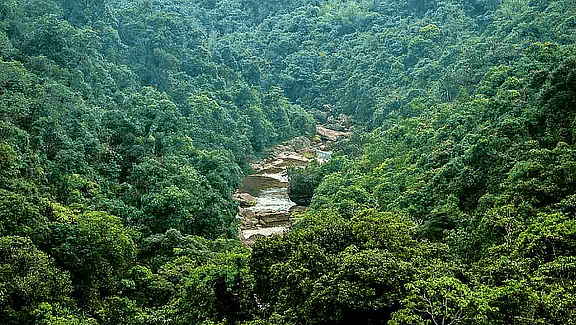 Indian Forestry
Indian Forestry
Climate, soil characteristics, topography, and elevation play pivotal roles in determining the specific type of forest that thrives in a particular area.
The nature and composition of these forests vary significantly, influenced by the unique climate conditions in which they flourish and their interconnectedness with the surrounding environment.
Champion and Seth Classification of Forest: Forest types in India have been systematically categorized by Champion and Seth into sixteen distinct types.
Tropical Wet Evergreen Forests
- Found in Western Ghats, Andaman and Nicobar Islands, and northeastern region.
- Characterized by tall, straight evergreen trees like jackfruit, betel nut palm, jamun, mango, and hollock.
- Tier pattern of shrubs, short structured trees, and tall trees with ferns and orchids on trunks.
Tropical Semi-Evergreen Forests
- Located in Western Ghats, Andaman and Nicobar Islands, and Eastern Himalayas.
- Features a mix of wet evergreen and moist deciduous trees.
- Densely populated with a diverse variety of trees.
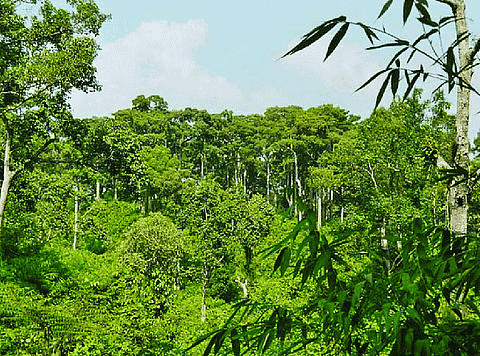 Tropical Semi-Evergreen Forest
Tropical Semi-Evergreen ForestTropical Moist Deciduous Forests
- Spread throughout India except for western and northwestern regions.
- Characterized by tall trees with broad trunks, shedding leaves in the dry season.
- Dominated by sal and teak, along with mango, bamboo, and rosewood, with an undergrowth of shorter trees and evergreen shrubs.
Littoral and Swamp Forests
- Found along Andaman and Nicobar Islands and the delta areas of Ganga and Brahmaputra.
- Adapted roots for breathing in water.
Tropical Dry Deciduous Forests
- Present in the northern part of India, excluding the North-East, and in Madhya Pradesh, Gujarat, Andhra Pradesh, Karnataka, and Tamil Nadu.
- Canopy height typically does not exceed 25 meters, featuring common trees like sal, various acacia species, and bamboo.
Tropical Thorn Forests
- Found in areas with black soil in North, West, Central, and South India.
- Trees do not exceed 10 meters; typical vegetation includes spurge, caper, and cactus.
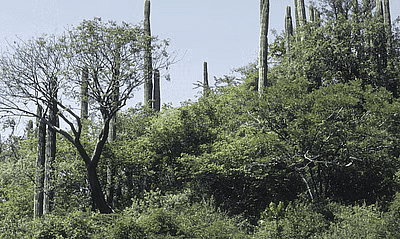 Tropical Thorn Forest
Tropical Thorn ForestTropical Dry Evergreen Forest
- Located along the coasts of Tamil Nadu, Andhra Pradesh, and Karnataka.
- Mainly consists of hard-leaved evergreen trees with fragrant flowers, along with a few deciduous trees.
Subtropical Broad-leaved Forests
- Found in the Eastern Himalayas and the Western Ghats, along the Silent Valley.
- Differences in vegetation: poonspar, cinnamon, rhododendron, and fragrantgrass in SilentValley; oak, alder, chestnut, birch, and cherry trees in Eastern Himalayas.
- Presence of a large variety of orchids, bamboo, and creepers.
Subtropical Pine Forests
- Found in the Shivalik Hills, Western and Central Himalayas, Khasi, Naga, and Manipur Hills.
- Predominantly includes chir, oak, rhododendron, pine, sal, amla, and laburnum in lower regions.
Subtropical Dry Evergreen Forests
- Typically has a prolonged hot and dry season and a cold winter.
- Found in the Shivalik Hills and foothills of the Himalayas up to a height of 1000 meters.
Montane Wet Temperate Forests
- Found in the eastern region of Nepal into Arunachal Pradesh with a minimum rainfall of 2000 mm.
- Three layers of forests: coniferous in the higher layer, deciduous like oak in the middle layer, and rhododendron and champa in the lowest layer.
- Also found in parts of the Nilgiri Hills and higher reaches of Kerala.
 Montane Wet Temperate Forests
Montane Wet Temperate ForestsHimalayan Moist Temperate Forest
- Spreads from the Western Himalayas to the Eastern Himalayas.
- Trees vary, including broad-leaved oak, brown oak, walnut, rhododendron in the west, and a more lush variety in the east.
Himalayan Dry Temperate Forest
- Found in Lahul, Kinnaur, Sikkim, and other parts of the Himalayas.
- Predominantly coniferoustrees, with broad-leaved trees like oak, maple, and ash at higher elevations.
Subalpine Forest
- Extends from Kashmir to Arunachal Pradesh between 2900 to 3500 meters.
- Vegetation includes juniper, rhododendron, willow, and black currant in the west; red fir, black juniper, birch, and larch in the east.
- Rhododendron of many species covers the hills in these parts.
Moist Alpine Scrub
- Found along the Himalayas and higher hills near the Myanmar border.
- Features a low scrub, dense evergreen forest with rhododendron and birch; patches of mosses and ferns cover the ground.
Dry Alpine Scrub
- Found from about 3000 meters to about 4900 meters.
- Dominated by dwarf plants, including black juniper, drooping juniper, honeysuckle, and willow.
Indian State of Forest Report, 2021
- The India State of Forest Report 2021 is the 17th in the series, utilizing data from the indigenous Resourcesat-11 satellite's LISS II sensor.
- Ground truthing follows the interpretation of satellite data for accuracy.
- The country's total forest and tree cover is 24.39% of the total geographical area, with an increase of 2,261 sq km from the 2019 assessment.
- Very dense forest (VDF) has grown by 500 sq km, crucial for carbon dioxide absorption.
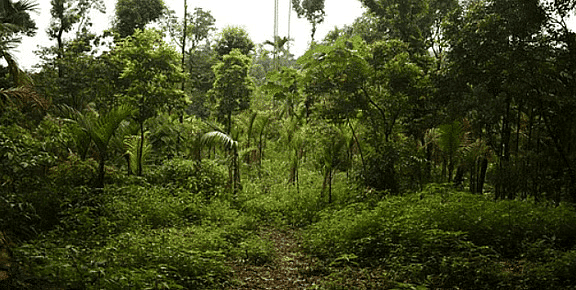 Very Dense Forest(VDF)
Very Dense Forest(VDF)
- Madhya Pradesh leads in forest cover, followed by Arunachal Pradesh and Chhattisgarh.
- Top five states by forest cover as a percentage of total geographical area: Mizoram (84.53%), Arunachal Pradesh (79.33%), Meghalaya (76.00%), Manipur (74.34%), and Nagaland (73.90%).
- 17 states/UTs have over 33% of the geographical area under forest cover, with five exceeding 75%.
- Total mangrove cover in the country is 4,992 sq km, showing an increase of 17 sq km since 2019.
- The country's total carbon stock in forests is 7,204 million tonnes, with a rise of 79.4 million tonnes since 2019.
- The report introduces assessments of forest cover in tiger reserves, tiger corridors, and the Gir forest.
- Between 2011-2021, forest cover increased in tiger corridors but decreased in tiger reserves.
- Forest cover increased in 20 tiger reserves but decreased in 32.
- Climate change impact is expected in 45% of forests by 2030, with some states identified as highly vulnerable climate hot spots.
- Shifting trends in vegetation types are observed, with Sikkim showing changes in vegetation patterns for 124 endemic species.
- Forest fire hotspots increased from 1.2 lakh in 2019-20 to 3.4 lakh in 2020-21, with Odisha, Madhya Pradesh, and Chhattisgarh detecting the highest number of fires.
Forest Acts and Policies
National Forest Policy 1988
- The primary goal of the National Forest Policy (1988) is to ensure environmental stability, maintain ecological balance, and preserve atmospheric equilibrium crucial for the sustenance of all life forms.
Objectives
Conserve the natural heritage of the country by preserving the remaining natural forests, showcasing diverse flora and fauna, and representing remarkable biological diversity and genetic resources.
Combat soil erosion and denudation in catchment areas of rivers, lakes, and reservoirs, contributing to soil and water conservation, flood and drought mitigation, and prevention of reservoir siltation.
Control the expansion of sand dunes in Rajasthan's desert areas and along coastal tracts.
 Sand Dunes
Sand Dunes
Substantially increase forest/tree cover through massive afforestation and social forestry programs, especially on denuded, degraded, and unproductive lands.
Enhance forest productivity to meet essential national needs.
Promote efficient utilization of forest produce and maximize the substitution of wood.
Achievements of National Forest Policy, 1988
Increased forest and tree cover.
Engaged local communities in forest protection, conservation, and management through the Joint Forest Management Program.
Addressed the fuelwood, fodder, minor forest produce, and small timber requirements of rural and tribal populations.
Contributed to the conservation of biological diversity and genetic resources through ex-situ and in-situ conservation measures.
Significantly contributed to the maintenance of environmental and ecological stability in the country.
 Biological Diversity
Biological Diversity
The Scheduled Tribes And Other Traditional Forest Dwellers (Recognition of Forest Rights) Act, 2006:
The Forest Rights Act, 2006, aims to restore deprived forest rights across India, encompassing both individual rights to cultivated land in forestland and community rights over common property resources.
Significant for integrating conservation and livelihood rights, empowering local self-governance, addressing livelihood security, and managing natural resources and conservation governance.
Recognizes and secures community rights, allowing communities to protect, regenerate, conserve, or manage any community forest resource traditionally safeguarded for sustainable use.
Acknowledges rights to intellectual property and traditional knowledge related to biodiversity and cultural diversity.
Recognizes rights of displaced communities and rights over developmental activities.
Forest Rights Act (FRA)
The Forest Rights Act (FRA) serves as a powerful tool with multiple purposes:
It aims to empower and strengthen local self-governance.
The Act addresses the crucial matter of ensuring livelihood security for the people.
FRA plays a pivotal role in addressing issues related to the conservation and management of natural resources, contributing to the overall governance of conservation efforts in India.
In its distinctive features, the Forest Rights Act:
Recognizes and secures community rights in addition to individual rights.
Grants the right to protect, regenerate, conserve, or manage any community forest resource that communities have traditionally safeguarded for sustainable use.
Acknowledges the right to intellectual property and traditional knowledge related to biodiversity and cultural diversity.
Safeguards the rights of displaced communities and provides entitlements over developmental activities.
Salient Features
Implemented through MaTA as the central agency.
Applicable to Tribal and Other Traditional Forest Dwelling Communities.
Recognizes forest rights for those relying on forests for livelihood for at least three generations before 13.12.2005.
Maximum limit for recognizing rights on forest land is 4 hectares.
Includes National Parks, Sanctuaries, Reserve Forests, and Protected Forests for rights recognition.

Acknowledges rights to collect, use, and dispose of minor forest produce.
Permits forest land diversion for government purposes like schools, hospitals, and infrastructure.
Conferred rights are heritable but not transferable.
Gram Sabha is the competent authority for determining individual or community forest rights for forest dwelling Scheduled Tribes and other traditional forest dwellers.
Forest Conservation Rules 2022 Overview
According to the Forest (Conservation) Act, 1980, the Central Government's approval under the Act serves as a prerequisite that doesn't inherently lead to non-forestry use or the disruption of forest land. The Forest (Conservation) Rules, 2022, are introduced explicitly to facilitate the implementation of the Forest (Conservation) Act, 1980.
Salient Features
Committee Formation
- The rules establish various committees, including an Advisory Committee, regional empowered committees at integrated regional offices, and screening committees at the State/Union Territory government level.
Compensatory Afforestation
- Applicants diverting forest land in hilly or heavily forested states can now conduct compensatory afforestation in states/UTs with less than 20% forest cover.
Private Plantations
- The rules permit private entities to cultivate plantations and sell them as land to companies aiming to meet compensatory afforestation targets.
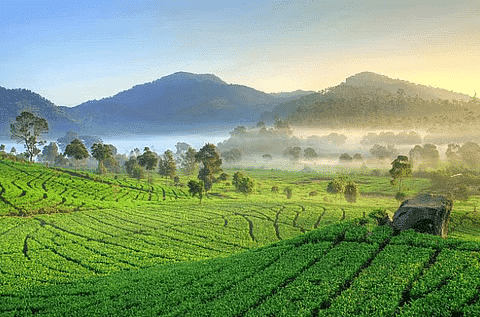 Private Tea Plantation
Private Tea Plantation
- The rules permit private entities to cultivate plantations and sell them as land to companies aiming to meet compensatory afforestation targets.
Simplified Approval Process
- Previously, state bodies forwarded documents to the Forest Advisory Committee (FAC) and included information on the settlement of forest rights for local communities. The updated rules streamline the process, with FAC approval leading to state authorities collecting compensatory funds and land for final approval.
Gram Sabha Consent Not Required
- Unlike before, the new rules state that projects approved by the FAC won't require written consent from the gram sabha or village governing body.
Construction in Forests
- The rules permit the construction of structures for legitimate purposes, such as forest protection measures and residential units (up to 250 sq meters as a one-time relaxation).
Government Measures
National Afforestation and Eco-Development Board Overview
The Ministry of Environment and Forests established the National Afforestation and Eco-development Board (NAEB) in August 1992. This board has developed specific schemes to promote afforestation and management strategies, aiding states in crafting tailored afforestation, management, and eco-development plans. These initiatives aim to enhance biomass production through participatory planning, focusing on Joint Forest Management and microplanning.
National Afforestation Programme: In 2002, the National Afforestation Programme (NAfP) was launched, targeting plantation activities in degraded forests nationwide. As a flagship initiative of the National Afforestation and Eco-development Board (NAEB), NAfP provides both physical and capacity-building support to the Forest Development Agencies.
Compensatory Afforestation Fund Management and Planning Authority (CAMPA)
- In the context of granting prior approval under the Forest (Conservation) Act, 1980 for forest land diversion, the Central Government mandates user agencies to contribute funds for compensatory afforestation and related activities.
- Established in April 2004 in response to Supreme Court directives, CAMPA's role includes managing funds for compensatory afforestation and ensuring compliance with Central Government stipulations and the Forest (Conservation) Act.

- Operational delays occurred as the Compensatory Afforestation Fund Bill 2008 did not pass in Parliament, resulting in the lapse of CAMPA's operationalization, despite being conceptualized by the Supreme Court in 2002.
- An Ad-hoc Authority, as directed by the Supreme Court, currently oversees State-wise accounts, comprising officials from the Ministry of Environment, Forests and Climate Change, a representative of the Comptroller and Auditor General, and a representative of the Central Empowered Committee.
- In response to fund accumulation and the lack of a permanent institutional mechanism, the Central Government introduced the Compensatory Afforestation Fund Bill, 2015 in the Lok Sabha on May 8, 2015.
- The Bill proposes the establishment of funds under the public accounts of India and each State, crediting monies received from user agencies for compensatory afforestation and associated activities.
- Allocation includes compensatory afforestation, net present value of the forest (NPV), and other project-specific payments, with the National Fund receiving 10%, and the State Funds receiving the remaining 90%.
- Funds are primarily directed toward afforestation to compensate for the loss of forest cover, regeneration of the forest ecosystem, wildlife protection, and infrastructure development.
- The Bill establishes the National and State Compensatory Afforestation Fund Management and Planning Authorities to administer and utilize the funds at the national and state levels.
Salient Features of CAMPA
- CAMPA is mandated to manage funds for compensatory afforestation and ensure compliance with Central Government stipulations and the Forest (Conservation) Act.
- Funds are currently overseen by an Ad-hoc Authority, as directed by the Supreme Court, comprising officials from relevant government bodies.
- A legislative response, the Compensatory Afforestation Fund Bill, 2015, aims to establish permanent funds under the public accounts of India and each State.
 Afforestation
Afforestation
- The proposed allocation includes compensatory afforestation, net present value of the forest (NPV), and other project-specific payments, with a distribution of 10% to the NationalFund and 90% to State Funds.
- Funds are primarily intended for afforestation, addressing the loss of forest cover, regenerating the forest ecosystem, wildlife protection, and infrastructure development.
- The legislative initiative proposes the establishment of the National and State Compensatory Afforestation Fund Management and Planning Authorities to administer and utilize funds at different levels.
Joint Forest Management (JFM)
Joint Forest Management (JFM) institutionalizes participatory governance of forest resources involving local communities.
- Co-management between forest fringe communities and the Forest Department.
- Aligned with the National Forest Policy 1988,JFM fosters partnerships based on mutual trust.
- Adopted by states in varying institutional structures.
- Forms committees for joint forest management, sharing costs and benefits.
- Forest departments initiate committees, often with NGO assistance.
- Key goal: Rehabilitating degraded forestlands with local participation.
- Win-win situation, enhancing access to minor forest products for both parties.
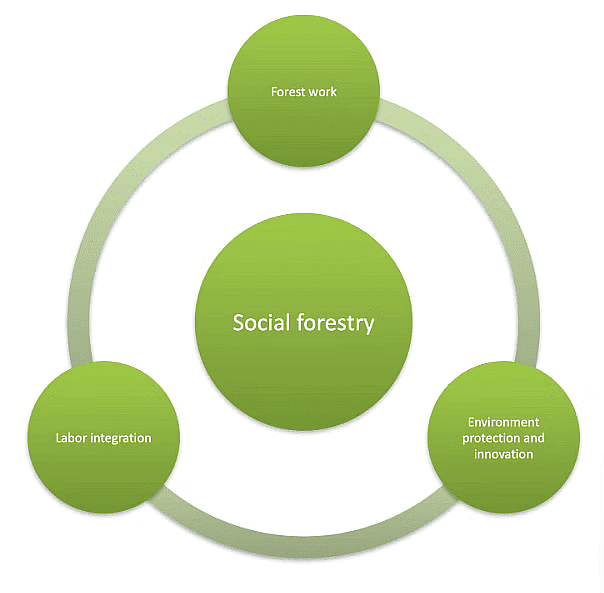
Social Forestry
Social Forestry, introduced in 1976, aims to alleviate forest pressure and use fallow land.
- Afforests degraded areas around human settlements, railways, roadsides, and more.
- Involves local communities in naturalresource management, recognizing their rights.
- Categorized into Farm Forestry, Community Forestry, Extension Forestry, and Recreational Forestry.
- Farm Forestry: Individual farmers plant non-commercial trees on farmland.
- Community Forestry: Trees raised on community land, with government support.
- Extension Forestry: Trees planted on roadsides and wastelands to expand forests.
- Recreational Forestry: Focuses on raising trees for recreational purposes.
Popular Movements
Chipko Movement
Chipko Movement, a socio-ecological initiative, employed Gandhian methods to protect trees through non-violent resistance, emphasizing tree-hugging.
- Emerged in the early 1970s in GarhwalHimalayas of Uttarakhand due to rising deforestation concerns.
- Pivotal moment on March 26, 1974, when peasant women in Renivillage resisted tree cutting, defending traditional forest rights.
- Catalyst for grassroots actions across the region, spreading nationwide in the 1980s.
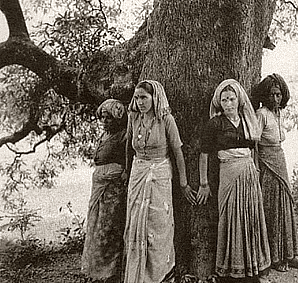 Chipko Movement
Chipko Movement
- Resulted in people-centric forest policies, curbing open felling in regions like Vindhyas and Western Ghats.
- The initial recorded instance occurred in 1730 AD in Khejarlivillage, inspiring the later GarhwalChipko movement.
Appiko Movement
Appiko Movement, a Karnataka-based environmental conservation movement, drew inspiration from the Chipko Movement in Uttarakhand.
- Sparked in September 1983 in Salkani, Karnataka, with locals adopting tree-hugging ("appiko") to save Kalase forest.
- Led to heightened environmental awareness in southernIndia, mirroring the success of the Chipko Movement.
Recent Developments
Updated Forest Cover Data – ISFR 2023:
- According to the India State of Forest Report 2023 by the Forest Survey of India (FSI), the total forest and tree cover of India is now approximately 24.62% of the geographical area, marking an increase of around 1,540 sq km since the 2021 assessment.
- Madhya Pradesh continues to lead in total forest cover area, followed by Arunachal Pradesh and Chhattisgarh.
- In terms of percentage of geographical area, the top five remain: Mizoram, Arunachal Pradesh, Meghalaya, Manipur, and Nagaland; however, minor changes in percentages reflect natural and anthropogenic factors.
- 17 states/UTs still have more than 33% of their geographical area under forest cover, with five exceeding 75% coverage.
- The total mangrove cover stands at approximately 4,991.68 sq km, showing a marginal decline since 2021, despite expansion efforts in certain states under the MISHTI scheme (Mangrove Initiative for Shoreline Habitats and Tangible Incomes) launched in 2023.
- The total carbon stock in forests has risen to about 7,276 million tonnes, an increase of over 70 million tonnes from 2021 figures.
State-Level Trends and Case Studies:
- Uttar Pradesh has significantly improved survival rates in its plantation drives, reaching up to 96% in 2024–25, increasing the state's green cover from 9.18% to nearly 10%.
- Kanpur district reported an increase of 4.12 sq km in forest cover between 2021 and 2023.
- Gujarat has shown recovery in tree cover after a 20% decline (2013–2021) through mangrove restoration under MISHTI and other coastal initiatives.
- Haryana has faced challenges in increasing forest cover, with only about 55% of the allocated CAMPA funds utilised, leading to slow progress.
Mangrove Conservation – MISHTI Scheme:
- Introduced in the Union Budget 2023–24, MISHTI focuses on mangrove plantation along coastlines and saltpan areas, integrating community livelihoods.
- Gujarat, West Bengal, and Odisha have emerged as leading states in MISHTI implementation, with thousands of hectares brought under new mangrove cover.
Policy and Legislative Updates:
- The Forest (Conservation) Rules, 2022 remain in force, but debates continue regarding the removal of mandatory Gram Sabha consent before diversion of forest land for projects. Multiple states have issued operational guidelines aligning with the new rules.
- The Compensatory Afforestation Fund (CAF) Act, fully operationalised, now guides both National and State CAMPA Authorities in fund utilisation. Despite this, certain states like Haryana and Jharkhand show under-utilisation of funds, raising concerns about implementation efficiency.
- Recent Supreme Court observations in 2023–24 have emphasised balancing development needs with tribal rights and biodiversity protection under the Forest Rights Act (FRA), especially in sensitive tiger corridors.
Climate Change & Forest Vulnerability:
- FSI’s 2023 vulnerability mapping shows that nearly 46% of India’s forests are at risk of significant climate-induced changes by 2035, with Himalayan and North-Eastern forests most affected.
- States like Sikkim continue to witness shifts in vegetation patterns, impacting endemic species; updated mapping has expanded to track changes for over 150 species (up from 124 in 2021).
Forest Fires and Disaster Risk:
- Forest fire hotspots remained high, with over 3.2 lakh incidents recorded in 2022–23. Odisha, Chhattisgarh, and Madhya Pradesh remained the worst affected.
- Integration of Van Agni (forest fire early warning system) with FSI’s satellite-based alerts has reduced response time in several states.
New Afforestation and Conservation Initiatives:
- Expansion of the National Afforestation Programme with added focus on urban forestry, including Nagar Van schemes in over 400 cities.
- Introduction of People’s Biodiversity Registers in forest fringe villages to record traditional ecological knowledge alongside biodiversity data.
- Integration of mangrove, wetland, and coastal forest restoration into National Adaptation Fund on Climate Change (NAFCC) programmes.
|
744 videos|1444 docs|633 tests
|
FAQs on Shankar IAS Summary: Indian Forest - Famous Books for UPSC Exam (Summary & Tests)
| 1. What are the major types of forests found in India? |  |
| 2. What key findings were reported in the Indian State of Forest Report, 2021? |  |
| 3. What are the significant forest-related acts and policies in India? |  |
| 4. What measures has the Indian government taken to enhance forest conservation? |  |
| 5. How have popular movements influenced forest conservation policies in India? |  |















